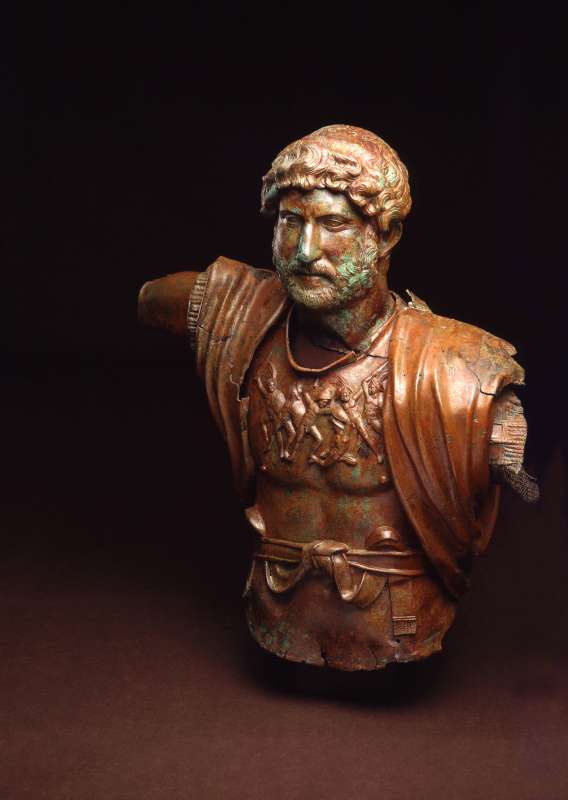Bvlgari Roma Rare Moneta Bracelet In 18Kt Yellow Gold With 117 AD Ancient Roman Coin
A rare Monete bracelet designed by Bvlgari.
An iconic and popular piece created in Rome, Italy by the jewelry house of Bvlgari, back in the 1970's. This rare Monete bracelet has been crafted, with classic Roman-revival patterns in solid yellow gold of 18 karats, with high polished finish. It is composed by a twisted braided leather straps of 7 mm, with the mounting element holding a genuine ancient Roman coin. It is suited with a double cylindrical push lock.
The coin, is a rare genuine bronze Quadrans or Semis (17 mm) of 4.05 Grams, from the ancient period of the Roman empire, attributed to the Emperor Hadrianus (117-138 AD). It is "attributed" because omits the name and portrait of the emperor. The anonymous types are attributed to the period from Domitian (81-96) through Antoninus Pius (138-160) or possibly as late as Marcus Aurelius.
Obverse description: The bearded portrait bust of Mars in high crested helmet facing to the right in a plain field.
Reverse description: An unidentified Statue (cuirass) Probably the statue of Hadrian, with the letters S C (Senatorum Consultae). at each sides.
 Statue of the emperor Hadrian, Camp of the sixth Roman Legion, Tel Shalem, Beth Shean Valley, Israel.
Statue of the emperor Hadrian, Camp of the sixth Roman Legion, Tel Shalem, Beth Shean Valley, Israel.
This bracelet have a total weight of 39.7 Grams and fit a wrist up to 6.75 Inches (17 Cm). The measures of the main decorative element is 21 mm by 46 mm (0.83 x 1.81 Inches).
Stamped, with the maker's mark, French Import mark, the Italian gold assay hallmarks, the coin origin description and signed in full, "BVLGARI ROMA *160ROMA .750 HADRIANVS QVADRANS 117-138 AD".
Numismatist literature: Similar to, RIC II page 218, 19.
Note: Quadrans (literally meaning "a quarter") or teruncius was a low-value Roman bronze coin worth one quarter of an as. The quadrans was issued from the beginning of cast bronze coins during the Roman Republic with three pellets representing three unciae as a mark of value. In the first and second centuries AD the quadrans was the smallest Roman coin denomination. It was not worth much then, it was not issued in large numbers, and it was not hoarded, so is not common now. The semis was worth two quadrantes (quadrans is singular, quadrantes is plural) and is even less common. Production of both stopped sometime in the middle of the second century, probably because inflation finally made them worth too little.
Bvlgari, was founded in the late 19th century by Sotirio Bulgari, who was born in 1857 in Greece and was descended from a talented family of silversmiths. In 1884 he opened his first shop in Rome on the Via Sistina, and then in 1905 he moved to the actual flag's store in Via dei Condotti. Upon Sotirio’s death in 1932 his sons, Giorgio and Costantino, took over the business. They are credited with creating the highly distinctive ‘Bvlgari’ style, inspired by Greek and Roman classicism revival, the Italian Renaissance, and the 19th century Roman school of goldsmiths. The 1970s marked the beginning of Bulgari’s international expansion with the opening of stores in New York (the first overseas), Paris, Geneva and Monte Carlo.
Monete Jewels by Bulgari
The practice of mounting coins for wear as jewelry has a long history dating back to ancient Roman times. Coins were not only minted as a unit of value for transactions, but the images appearing on them could be symbols of power, sometimes talismanic, and could represent alliances between countries. Nicola Bulgari, grandson of the founder of the firm, who developed an interest in coin collecting, can be credited as the “influencer” who was responsible for the launch of Bulgari’s modern tradition of mounting ancient coins in the mid-1960s. The use of ancient Greek and Roman coins also forged a firm connection with Bulgari’s proud Hellenic and Roman cultural heritage. Coins used in Bulgari jewels date from the 5th century B.C. to the 20th century A.D., depending in part on what is available in the market. Each coin has been thoroughly researched and the reverse of each mounting is inscribed with the name of the individual or region featured and the year of issue, inscribed in Roman font. Coins with irregular contours are mounted in such a way that the integrity of the coin is uncompromised; the mounting follows the shape of the coin so not to diminish its numismatic value. The scholarly aspect of Bulgari’s “Gemme Nummarie” (coin gems, derived from Latin), sets them above all imitators. Also referred to as simply “Monete” (coins, in Italian), Bulgari coin jewels can bestow status upon the wearer and be the source of stimulating intellectual conversation, but most importantly they show great respect for tradition while successfully linking antiquity with the present. (From Sotheby's with thanks).
It is in great condition and the coin is a collectable numismatist interest, with a beautiful portrait in high relief, well centered strike and with great patina.
INVENTORY REF: B0000MANN/.9543


























